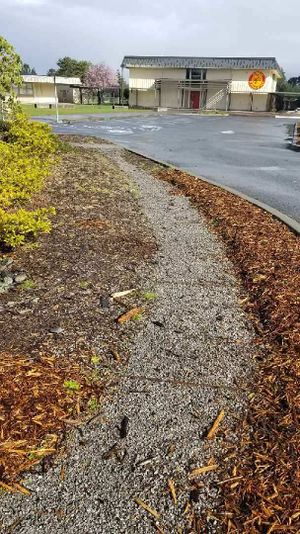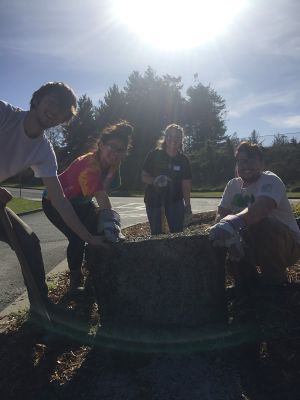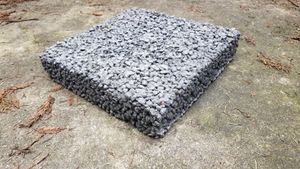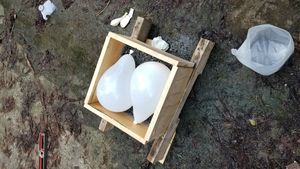Abstract

The purpose of the project was to replace a incorrectly installed permeable pathway at Catherine Zane Middle School in Eureka, CA with a functioning permeable pathway. The previously installed pathway was uneven, and not permeable and produced undesirable loose gravel. The Project was successfully implemented and the middle school now has a solid, level but permeable concrete pathway in the Peace Garden.
Background
The project is being design and installed by Team^2 whose members are Ailynn Andersen, Jesse Bobrow, Catherine Carbajal and Julian Sicaud. Team^2 is a team in HSU's Engineering 215: intro to Design course taken in Spring 2018 and taught by Lonny Grafman. The client of the project is Catherine Zane Middle School, a STEAM(Science Technology Engineering and Math) who has had a relationship with facilitation projects on their campus for ENGR 215 courses. Team^2 client representative is Trevor Hammons.

Problem statement and criteria
In the Peace Garden a previous engineering team had incorrectly installed a permeable concrete pathway. We hypothesized that there was too much water in their mix which caused the cement to sink to the bottom of their installation and harden into an impermeable layer leaving too little cement in the top layer to properly set the top layer. Aggregate erosion resulted in loose gravel, which pedestrians tracked across campus. Our client wished us to solve these issues by implementing a pathway that was strong and durable, seamless with the other pathways and level and also permeable.
| Criteria | Weight (1-10) |
|---|---|
| Durability | 10 |
| Permeability | 10 |
| Functionality | 8 |
| Maintenance | 7 |
| Cost | 6 |
| Educational Value | 5 |
Description of final project
Images coming soon!
Prototyping

Permeable Concrete is made from a mix of, ideally, equal sized round aggregates and Portland cement. typical mixtures are usually a 3:1 ratio of 3 part 3/8" pea gravel aggregate to one part Portland cement. We decided to test both permeability and viability as product of this ratio by testing it against a 4:1 ratio of aggregate to cement and a 2:1 ratio of aggregate to cement. We poured samples of each ratio into a one foot square mold to the depth of three inches.

Costs
| Materials | Source | Quantity | Unit | Retail Price per unit ($) | Total Retail ($) | Expenses ($) |
|---|---|---|---|---|---|---|
| 3/8" Washed Pea Gravel | Mercer-Fraser | 2 | Cubic Yard | 60.00 | 120.00 | Donated |
| 3/8" Washed Pea Gravel | Hensell Materials | 2 | 5 gallon bucket | 4.00 | 4.50 | Donated |
| Weed Cloth | Zane Middle School | 1.2 | 100 feet | 68.99 | 68.99 | Donated |
| Mixing Wheelbarrow | Larry Nichols/Zane | 2 | 150.00 | 300.00 | Donated | |
| 5 Gal. Bucket | Julian Sicaud | 4 | 4.99 | 4.99 | Donated | |
| 1 Foot Wooden Stakes | Zane Middle School | 1 | 100 Stakes | 17.50 | 17.50 | Donated |
| Bender Board | Zane Middle School | 6 | 20 Feet | 19.99 | 120.00 | Donated |
| Fill Dirt | Zane Middle School | 2 | Cubic Yard | 7.99 | 15.99 | Donated |
| Portland Cement | Piersons Hardware | 5 | 97 lb bag | 16.99 | 84.95 | Donated |
| Tarp | Julian Sicaud | 2 | 15.99 | 31.98 | Donated | |
| Shovel | Julian Sicaud | 2 | 23.86 | 23.86 | Donated | |
| Portland Cement | Hensell Materials | 1 | 47 lb bag | 6.07 | 6.77 | 6.77 |
| Portland Cement | Shafer's Hardware | 1 | 47 lb bag | 9.99 | 10.84 | 10.84 |
| Line Level | Piersons Hardware | 1 | 3.69 | 4.00 | 4.00 | |
| Shovel | Piersons Hardware | 1 | 21.99 | 23.86 | 23.86 | |
| Garden Hoe | Shafers Hardware | 2 | 16.99 | 16.99 | 16.99 | |
| Hose Valve Key | Shafers Hardware | 1 | 1.79 | 1.79 | 1.79 | |
| #9 x 2-1/2" Deck Screws | Hensel's Hardware | 1 | 50 screws | 9.78 | 9.78 | 9.78 |
| Wood | Almquist | 14 | Feet | 1.09 | 16.44 | 16.44 |
| 1" x 4" pine | Piersons Hardware | 30 | Feet | 0.69 | 20.42 | 20.42 |
| Wheel barrow Tube | Miller Farms | 2 | 9.64 | 19.28 | 19.28 | |
| Caulking Gun | Harbor Freight Tools | 1 | 2.99 | 2.99 | 2.99 | |
| Silicone caulk | Harbor Freight Tools | 2 | Tube | 3.99 | 7.98 | 7.98 |
| Balloons | Dollar Tree | 5 | Bag of 25 | 1.00 | 5.43 | 5.43 |
| Caution Tape | Shafers Hardware | 1 | Roll | 7.59 | 7.59 | 7.59 |
| Gloves | Harbor Freight Tools | 5 | pair | 7.99 | 7.99 | 7.99 |
| Push Broom | Shafers Hardware | 1 | 7.99 | 7.99 | 7.99 | |
| Plastic Sheeting | Piersons Hardware | 1 | 9 x 400 Feet | 24.99 | 27.11 | 27.11 |
| TOTAL | 990.01 | 197.25 |
Testing Results
We ran three tests of permeability on each prototype ratio. To test our prototype slabs we built a box of wood around the slab and siliconed the inside corners. After this we filled the wooden box holding our prototype slabs with two water balloons filled with approximately 2 gallons of water. We then popped both of the balloons at the same time and timed how long it took for the water to permeate through the path. The table below contains the results of our tests.
| Trials | 2:1 ratio | 3:1 ratio | 4:1 ratio |
|---|---|---|---|
| Trial 1 | 7.08 sec. | 5.14 sec. | 3.59 sec. |
| Trial 2 | 6.72 sec. | 5.13 sec. | 3.42 sec. |
| Trial 3 | 7.03 sec. | 5.13 sec. | 3.49 sec. |
Maintenance
This type of permeable walkway only needs to be maintained about twice a year. The most effective way to maintain this path is to power wash it two times a year. This ensures that small objects will not clog the holes in the path way.
Instructions
This is how to maintain. The step by step how to template {{How to}} is most likely best for this part.
Troubleshooting
This is only how to troubleshoot basic operation. For complex issues, the solution might just say contact ________. It should be a table in this format:
| Problem | Suggestion |
|---|---|
| Example issue | Example solution or suggestion |
| Does not turn on | Make sure it is plugged in |
| Another issue | Et cetera |
Discussion and next steps
Suggestions for future changes
This is where to lay out suggestions for how to make the project function better in the future.
References
See Help:Footnotes for more. Template:Reflist